Characterization of Groundwater Dynamics and Their Response Mechanisms to Different Types of Compound Stress in a Typical Hilly Plain Area
Abstract
1. Introduction
2. Study Area and Data
2.1. Location of Study Area
2.2. Hydrogeological and Meteorological Characteristics
3. Data and Methods
3.1. Data Sources
3.2. Correlation Analysis (Auto-Correlation and Cross-Correlation)
3.3. Evaluation of Groundwater Dynamic Impact Factors by GIS-Based Multi-Factor Weighted Comprehensive Evaluation System (MFWCES)
4. Results and Discussion
4.1. Results of the Correlation Analysis
4.2. Results of the Groundwater Dynamics
4.3. Dynamics Discussion of Impact Evaluation for Groundwater Dynamic Characterization
4.3.1. Factors Influencing the Dynamic Characterization of Groundwater
- Hydraulic Conductivity
- 2.
- Soil Media
- 3.
- Aquifer Thickness
- 4.
- Depth of Groundwater
- 5.
- Land use type
- 6.
- Groundwater Extraction Intensity
- 7.
- Groundwater Evaporation
4.3.2. Results of the MFWCES-Based Evaluation of Groundwater Dynamics
4.4. Response Mechanisms and Validation of Groundwater Dynamic Characterization
4.4.1. Impact of Hydraulic Engineering and Human Activities on Groundwater Dynamics
4.4.2. Response Mechanisms for Characterizing Groundwater Dynamics
- Rapid response
- 2.
- Precipitation–artificial mining dual response
- 3.
- Delayed response
- 4.
- Strong superimposed response to human activities
4.4.3. Response Mechanism and Validation of Groundwater Dynamic Characterization
4.5. Future Monitoring and the Long-Term Sustainability of Groundwater Supplies
5. Conclusions
- (1)
- The auto-correlation coefficient of the groundwater level decreased from 0.8 to 0.2 in 60–75 days on average, and the correlation decreased slowly with an increase in lag time. The cross-correlation analysis of groundwater level and precipitation showed that, when the lag time was between 0 and 7 months, the cross-correlation coefficient changed from a weak negative correlation to no correlation to a weak positive correlation.
- (2)
- According to the characteristics of the groundwater dynamic curve and the results of the correlation analysis, the dynamic type of groundwater in Tangshan City was classified into four categories: precipitation-infiltration type, runoff type, irrigation-infiltration type, and artificial exploitation type.
- (3)
- The results of the GIS-based evaluation of MFWCES groundwater dynamics had a score size ranging from 2.4 to 12.7. Combining the two main categories of influencing factors of groundwater dynamics––natural factors and human activities––the response relationship of groundwater dynamics to precipitation was classified into four categories: rapid response (10.3–12.7), dual response to precipitation and anthropogenic extraction (9.6–10.3), delayed response (7.6–9.6), and strong superimposed response to human activities (2.4–7.6). Finally, the evaluation results were validated using the standard deviation of the groundwater level. The standard deviation was calculated to be in the range of 0.21 to 6.51. After validation, it was found that wells with relatively large standard deviations fell in areas with a high MFWCES evaluation index value. Moreover, the impact of water conservancy construction and human activities is particularly significant in LBQ, KPQ, LNX, and FNQ, while tides increase the periodicity of the dynamics. This study’s classification of groundwater dynamic response types, together with its quantitative assessment of groundwater reactions to precipitation, offers a novel perspective for regional water resource planning, ecological protection, and the development of differentiated groundwater management strategies under compound stress.
Author Contributions
Funding
Data Availability Statement
Conflicts of Interest
Appendix A
| Abbreviation of Administrative Region | Full Name of Administrative Region |
|---|---|
| ZHS | Zunhua Shi |
| QXX | Qianxi Xian |
| QAS | Qianan Shi |
| YTX | Yutian Xian |
| FRQ | Fengrun Qu |
| KPQ | Kaiping Qu |
| GZQ | Guzhi Qu |
| LZS | Luanzhou Shi |
| LBQ | Lubei Qu |
| LNQ | Lunan Qu |
| FNQ | Fengnan Qu |
| LNX | Luannan Xian |
| CFDQ | Caofeidian Qu |
| LTX | Leting Xian |
References
- Satoh, Y.; Kahil, T.; Byers, E.; Burek, P.; Fischer, G.; Tramberend, S.; Greve, P.; Flörke, M.; Eisner, S.; Hanasaki, N.; et al. Multi-model and multi-scenario assessments of Asian water futures: The Water Futures and Solutions (WFaS) initiative. Earth’s Future 2017, 5, 823–852. [Google Scholar] [CrossRef]
- Van Camp, M.; Mtoni, Y.; Mjemah, I.C.; Bakundukize, C.; Walraevens, K. Investigating seawater intrusion due to groundwater pumping with schematic model simulations: The example of the Dar es Salaam coastal aquifer in Tanzania. J. Afr. Earth Sci. 2014, 96, 71–78. [Google Scholar] [CrossRef]
- Sun, Y.; Xu, S.; Wang, Q.; Hu, S.; Qin, G.; Yu, H. Response of a Coastal Groundwater System to Natural and Anthropogenic Factors: Case Study on East Coast of Laizhou Bay, China. Int. J. Environ. Res. Public Health 2020, 17, 5204. [Google Scholar] [CrossRef]
- Schreiner-McGraw, A.P.; Ajami, H. Delayed response of groundwater to multi-year meteorological droughts in the absence of anthropogenic management. J. Hydrol. 2021, 603, 126917. [Google Scholar] [CrossRef]
- Sheng, Y.; Wang, G.; Zhao, D.; Hao, C.; Liu, C.; Cui, L.; Zhang, G. Groundwater Microbial Communities Along a Generalized Flowpath in Nomhon Area, Qaidam Basin, China. Groundwater 2018, 56, 719–731. [Google Scholar] [CrossRef]
- Giordano, M. Global groundwater? Issues and solutions. Annu. Rev. Environ. Resour. 2009, 34, 153–178. [Google Scholar] [CrossRef]
- Ahmad, S.; Liu, H.; Günther, A.; Couwenberg, J.; Lennartz, B. Long-term rewetting of degraded peatlands restores hydrological buffer function. Sci. Total Environ. 2020, 749, 141571. [Google Scholar] [CrossRef]
- Alfio, M.R.; Pisinaras, V.; Panagopoulos, A.; Balacco, G. Groundwater level response to precipitation at the hydrological observatory of Pinios (central Greece). Groundw. Sustain. Dev. 2024, 24, 101081. [Google Scholar] [CrossRef]
- Cui, Y.; Liao, Z.; Wei, Y.; Xu, X.; Song, Y.; Liu, H. The Response of Groundwater Level to Climate Change and Human Activities in Baotou City, China. Water 2020, 12, 1078. [Google Scholar] [CrossRef]
- Balacco, G.; Alfio, M.R.; Fidelibus, M.D. Groundwater Drought Analysis under Data Scarcity: The Case of the Salento Aquifer (Italy). Sustainability 2022, 14, 707. [Google Scholar] [CrossRef]
- Jin, G.; Shimizu, Y.; Onodera, S.; Saito, M.; Matsumori, K. Evaluation of drought impact on groundwater recharge rate using SWAT and Hydrus models on an agricultural island in western Japan. Proc. IAHS 2015, 371, 143–148. [Google Scholar] [CrossRef]
- Yin, X.; Shu, L.; Wang, Z.; Lu, C.; Liu, B. Time-frequency analysis of groundwater depth variation based on the ICA-WTC composite method. J. Hydrol. 2023, 617, 128914. [Google Scholar] [CrossRef]
- Russo, T.A.; Lall, U. Depletion and response of deep groundwater to climate-induced pumping variability. Nat. Geosci. 2017, 10, 105–108. [Google Scholar] [CrossRef]
- Wang, D.; Li, P.; He, X.; He, S. Exploring the response of shallow groundwater to precipitation in the northern piedmont of the Qinling Mountains, China. Urban Clim. 2023, 47, 101379. [Google Scholar] [CrossRef]
- Qi, P.; Zhang, G.; Xu, Y.J.; Wang, L.; Ding, C.; Cheng, C. Assessing the Influence of Precipitation on Shallow Groundwater Table Response Using a Combination of Singular Value Decomposition and Cross-Wavelet Approaches. Water 2018, 10, 598. [Google Scholar] [CrossRef]
- Kellner, E.; Hubbart, J.A. Land use impacts on floodplain water table response to precipitation events. Ecohydrology 2018, 11, e1913. [Google Scholar] [CrossRef]
- Jiang, W.; Sheng, Y.; Shi, Z.; Guo, H.; Chen, X.; Mao, H.; Liu, F.; Ning, H.; Liu, N.; Wang, G. Hydrogeochemical characteristics and evolution of formation water in the continental sedimentary basin: A case study in the Qaidam Basin, China. Sci. Total Environ. 2024, 957, 177672. [Google Scholar] [CrossRef]
- Schiavo, M. Probabilistic delineation of subsurface connected pathways in alluvial aquifers under geological uncertainty. J. Hydrol. 2022, 615, 128674. [Google Scholar] [CrossRef]
- Meng, Q.; Xing, L.; Liu, L.; Xing, X.; Zhao, Z.; Zhang, F.; Li, C. Time-lag characteristics of the response of karst springs to precipitation in the northern China. Environ. Earth Sci. 2021, 80, 348. [Google Scholar] [CrossRef]
- Fronzi, D.; Mirabella, F.; Cardellini, C.; Caliro, S.; Palpacelli, S.; Cambi, C.; Valigi, D.; Tazioli, A. The Role of Faults in Groundwater Circulation before and after Seismic Events: Insights from Tracers, Water Isotopes and Geochemistry. Water 2021, 13, 1499. [Google Scholar] [CrossRef]
- Tian, Y.; Yang, Y.; Bao, Z.; Song, X.; Wang, G.; Liu, C.; Wu, H.; Mo, Y. An Analysis of the Impact of Groundwater Overdraft on Runoff Generation in the North China Plain with a Hydrological Modeling Framework. Water 2022, 14, 1758. [Google Scholar] [CrossRef]
- Zhang, Q.; Shan, Q.; Chen, F.; Liu, J.; Yuan, Y. Groundwater Vulnerability Assessment and Protection Strategy in the Coastal Area of China: A GIS-Based DRASTIC Model Approach. Appl. Sci. 2023, 13, 10781. [Google Scholar] [CrossRef]
- Dai, X.; Xie, Y.; Liao, A.; Wang, C.; Lin, J.; Wu, J. Quantifying hydrological responses to monsoon-controlled precipitation across the soil-groundwater-stream continuum with long-term high-frequency hydrometric monitoring. Hydrol. Process. 2024, 38, e15089. [Google Scholar] [CrossRef]
- Royer-Carenzi, M.; Hassani, H. Deviations from Normality in Autocorrelation Functions and Their Implications for MA(q) Modeling. Stats 2025, 8, 19. [Google Scholar] [CrossRef]
- Li, W.; Bao, L.; Yao, G.; Wang, F.; Guo, Q.; Zhu, J.; Zhu, J.; Wang, Z.; Bi, J.; Zhu, C.; et al. The analysis on groundwater storage variations from GRACE/GRACE-FO in recent 20 years driven by influencing factors and prediction in Shandong Province, China. Sci. Rep. 2024, 14, 5819. [Google Scholar] [CrossRef] [PubMed]
- Wang, S.; Song, X.; Wang, Q.; Xiao, G.; Liu, C.; Liu, J. Shallow groundwater dynamics in North China Plain. J. Geogr. Sci. 2009, 19, 175–188. [Google Scholar] [CrossRef]
- Etuk, M.N.; Igwe, O.; Egbueri, J.C. An integrated geoinformatics and hydrogeological approach to delineating groundwater potential zones in the complex geological terrain of Abuja, Nigeria. Model. Earth Syst. Environ. 2023, 9, 285–311. [Google Scholar] [CrossRef]
- China Hydrology Society. Guidelines for Groundwater Dynamics Analysis and Evaluation; China Institute of Water Resources and Hydropower: Beijing, China, 2023. [Google Scholar]
- Zhong, X.; Gong, H.; Chen, B.; Zhou, C.; Xu, M. Study on the evolution of shallow groundwater levels and its spatiotemporal response to precipitation in the Beijing Plain of China based on variation points. Ecol. Indic. 2024, 166, 112466. [Google Scholar] [CrossRef]
- Duvert, C.; Jourde, H.; Raiber, M.; Cox, M.E. Correlation and spectral analyses to assess the response of a shallow aquifer to low and high frequency rainfall fluctuations. J. Hydrol. 2015, 527, 894–907. [Google Scholar] [CrossRef]
- Tirogo, J.; Jost, A.; Biaou, A.; Valdes-Lao, D.; Koussoubé, Y.; Ribstein, P. Climate Variability and Groundwater Response: A Case Study in Burkina Faso (West Africa). Water 2016, 8, 171. [Google Scholar] [CrossRef]
- Cao, G.; Scanlon, B.R.; Han, D.; Zheng, C. Impacts of thickening unsaturated zone on groundwater recharge in the North China Plain. J. Hydrol. 2016, 537, 260–270. [Google Scholar] [CrossRef]
- Richardson, C.M.; Davis, K.L.; Ruiz-González, C.; Guimond, J.A.; Michael, H.A.; Paldor, A.; Moosdorf, N.; Paytan, A. The impacts of climate change on coastal groundwater. Nat. Rev. Earth Environ. 2024, 5, 100–119. [Google Scholar] [CrossRef]
- Chala, D.C.; Quiñones-Bolaños, E.; Mehrvar, M. An integrated framework to model salinity intrusion in coastal unconfined aquifers considering intrinsic vulnerability factors, driving forces, and land subsidence. J. Environ. Chem. Eng. 2022, 10, 106873. [Google Scholar] [CrossRef]
- Zuecco, G.; Rinderer, M.; Penna, D.; Borga, M.; van Meerveld, H.J. Quantification of subsurface hydrologic connectivity in four headwater catchments using graph theory. Sci. Total Environ. 2019, 646, 1265–1280. [Google Scholar] [CrossRef]
- Kim, B.; Roh, G.; Lee, J.; Yoon, J.; Lee, J. Characterizing the hydraulic conductivity of soil based on the moving average of precipitation and groundwater level using a regional database. AQUA–Water Infrastruct. Ecosyst. Soc. 2023, 72, 1459–1473. [Google Scholar] [CrossRef]
- Lorenzo-Lacruz, J.; Garcia, C.; Morán-Tejeda, E. Groundwater level responses to precipitation variability in Mediterranean insular aquifers. J. Hydrol. 2017, 552, 516–531. [Google Scholar] [CrossRef]
- Corona, C.R.; Ge, S.; Anderson, S.P. Water-table response to extreme precipitation events. J. Hydrol. 2023, 618, 129140. [Google Scholar] [CrossRef]
- Nair, A.M.; Prasad, K.R.; Srinivas, R. Groundwater vulnerability assessment of an urban coastal phreatic aquifer in India using GIS-based DRASTIC model. Groundw. Sustain. Dev. 2022, 19, 100810. [Google Scholar]
- Cai, Y.; Huang, R.; Xu, J.; Xing, J.; Yi, D. Dynamic Response Characteristics of Shallow Groundwater Level to Hydro-Meteorological Factors and Well Irrigation Water Withdrawals under Different Conditions of Groundwater Buried Depth. Water 2022, 14, 3937. [Google Scholar] [CrossRef]
- Luo, F.; Wang, D.; Tian, X.; Bi, X.; Zheng, Q.; Zhou, Z.; Tang, Z. Estuarine groundwater level response to and recovery from extreme precipitation events: Typhoon Lekima in the Yellow River Delta. J. Hydrol. 2024, 632, 130918. [Google Scholar] [CrossRef]
- Siddik, M.S.; Tulip, S.S.; Rahman, A.; Islam, M.N.; Haghighi, A.T.; Mustafa, S.M.T. The impact of land use and land cover change on groundwater recharge in northwestern Bangladesh. J. Environ. Manag. 2022, 315, 115130. [Google Scholar] [CrossRef] [PubMed]
- Pinsri, P.; Shrestha, S.; Kc, S.; Mohanasundaram, S.; Virdis, S.G.P.; Nguyen, T.P.L.; Chaowiwat, W. Assessing the future climate change, land use change, and abstraction impacts on groundwater resources in the Tak Special Economic Zone, Thailand. Environ. Res. 2022, 211, 113026. [Google Scholar] [CrossRef]
- Yifru, B.A.; Chung, I.-M.; Kim, M.-G.; Chang, S.W. Assessing the Effect of Land/Use Land Cover and Climate Change on Water Yield and Groundwater Recharge in East African Rift Valley using Integrated Model. J. Hydrol. Reg. Stud. 2021, 37, 100926. [Google Scholar] [CrossRef]
- Chandrasekhar, P.; Kreiselmeier, J.; Schwen, A.; Weninger, T.; Julich, S.; Feger, K.-H.; Schwärzel, K. Why We Should Include Soil Structural Dynamics of Agricultural Soils in Hydrological Models. Water 2018, 10, 1862. [Google Scholar] [CrossRef]
- Wang, L.; Jia, B.; Xie, Z. How climate change and groundwater extraction will shape the global terrestrial water cycle pattern. J. Hydrol. 2024, 641, 131780. [Google Scholar] [CrossRef]
- Wakode, H.B.; Baier, K.; Jha, R.; Azzam, R. Impact of urbanization on groundwater recharge and urban water balance for the city of Hyderabad, India. Int. Soil Water Conserv. Res. 2018, 6, 51–62. [Google Scholar] [CrossRef]
- Niu, X.Y.; Lu, C.P.; Zhang, Y.; Zhang, Y.; Wu, C.C.; Saidy, E.; Liu, B.; Shu, L.C. Hysteresis response of groundwater depth on the influencing factors using an explainable learning model framework with Shapley values. Sci. Total Environ. 2023, 904, 166662. [Google Scholar] [CrossRef]
- Li, H.; Hou, E. Groundwater dynamic response mechanism and quantity vulnerability assessment under the influence of human activities. Environ. Sci. Pollut. Res. 2020, 27, 22046–22064. [Google Scholar] [CrossRef]
- Ahmed, M.; Aqnouy, M.; El Messari, J.S. Sustainability of Morocco’s groundwater resources in response to natural and anthropogenic forces. J. Hydrol. 2021, 603, 126866. [Google Scholar] [CrossRef]
- Lee, J.M.; Kwon, E.H.; Woo, N.C. Natural and Human-Induced Drivers of Groundwater Sustainability: A Case Study of the Mangyeong River Basin in Korea. Sustainability 2019, 11, 1486. [Google Scholar] [CrossRef]
- Agarwal, V.; Akyilmaz, O.; Shum, C.K.; Feng, W.; Yang, T.-Y.; Forootan, E.; Syed, T.H.; Haritashya, U.K.; Uz, M. Machine learning based downscaling of GRACE-estimated groundwater in Central Valley, California. Sci. Total Environ. 2023, 865, 161138. [Google Scholar] [CrossRef] [PubMed]
- Deines, J.M.; Kendall, A.D.; Butler, J.J.; Basso, B.; Hyndman, D.W. Combining Remote Sensing and Crop Models to Assess the Sustainability of Stakeholder-Driven Groundwater Management in the US High Plains Aquifer. Water Resour. Res. 2021, 57, e2020WR027756. [Google Scholar] [CrossRef]
- Rodell, M.; Velicogna, I.; Famiglietti, J.S. Satellite-based estimates of groundwater depletion in India. Nature 2009, 460, 999–1002. [Google Scholar] [CrossRef] [PubMed]
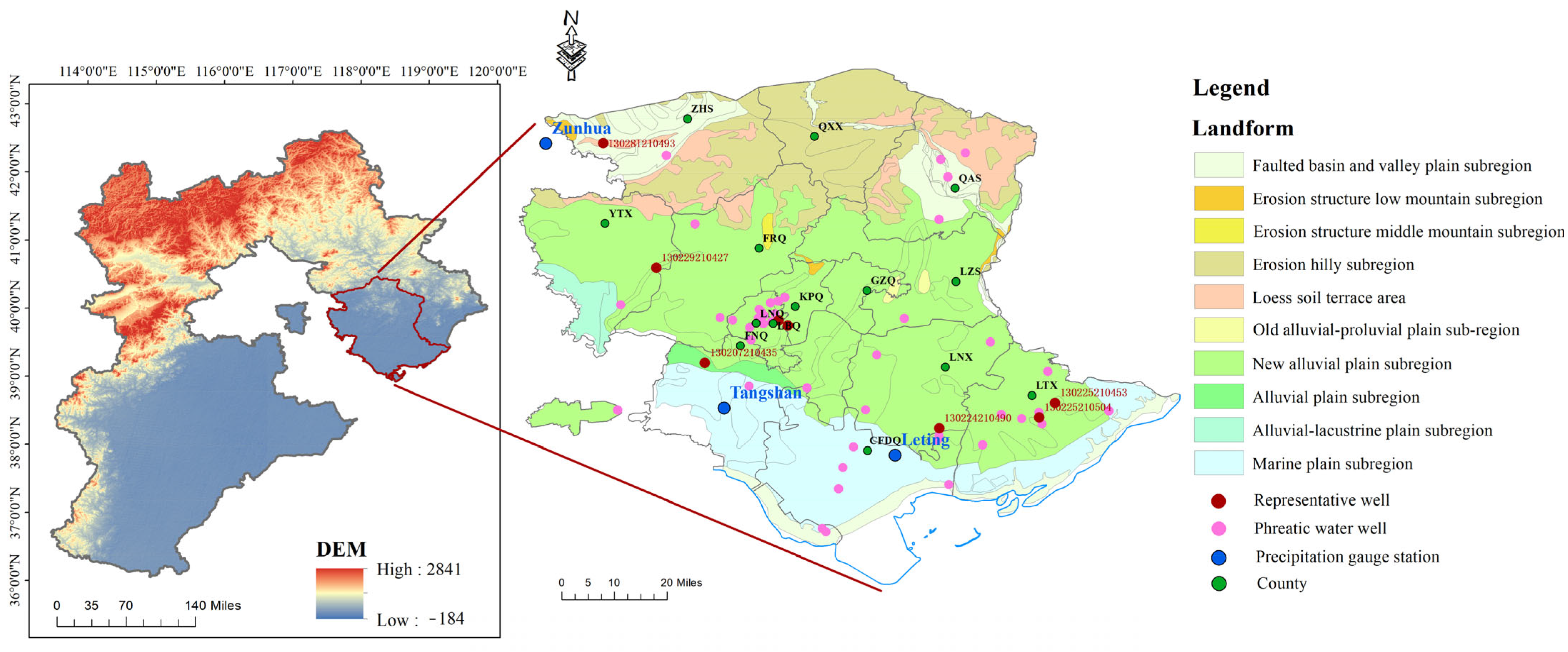
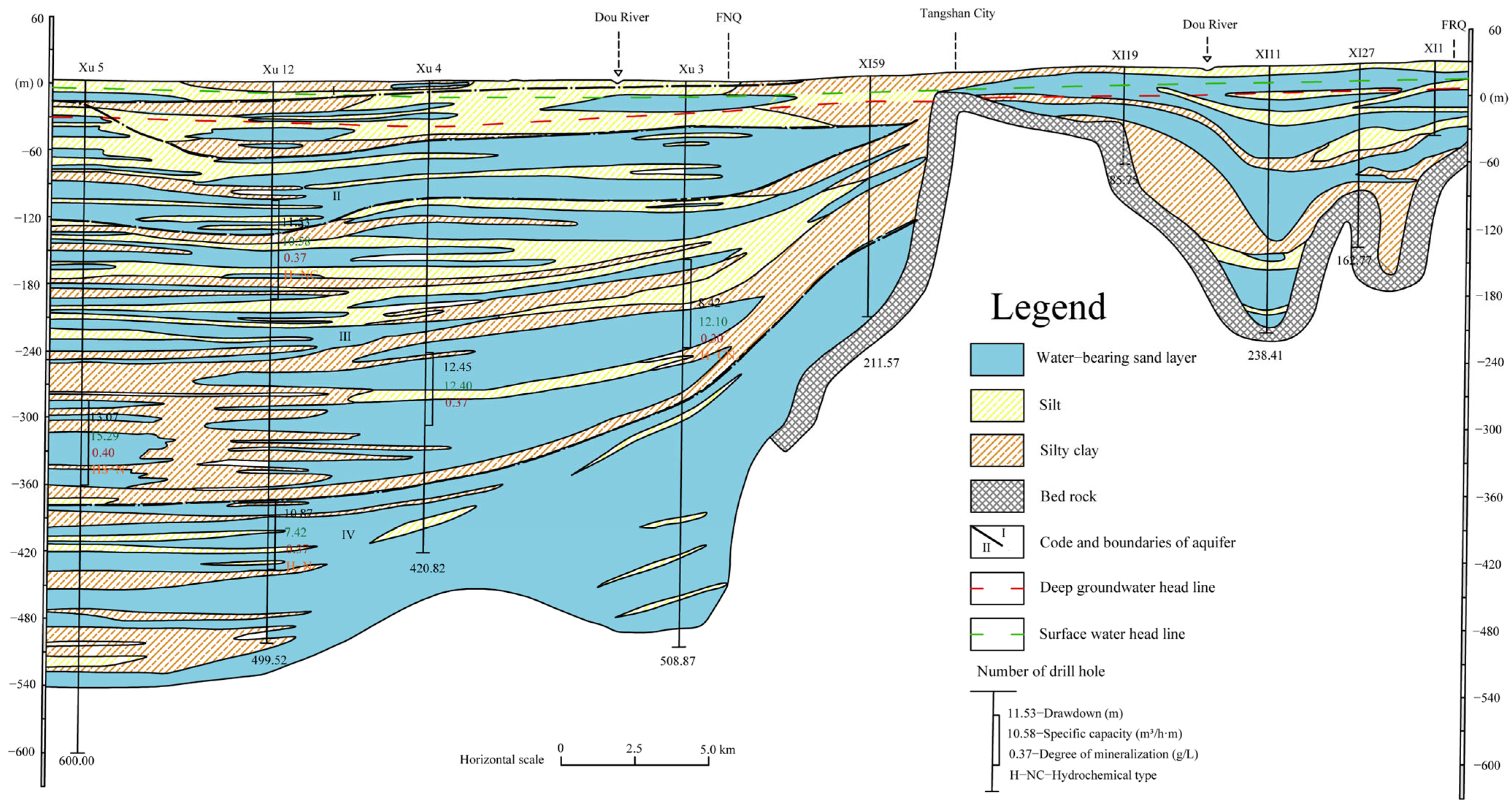
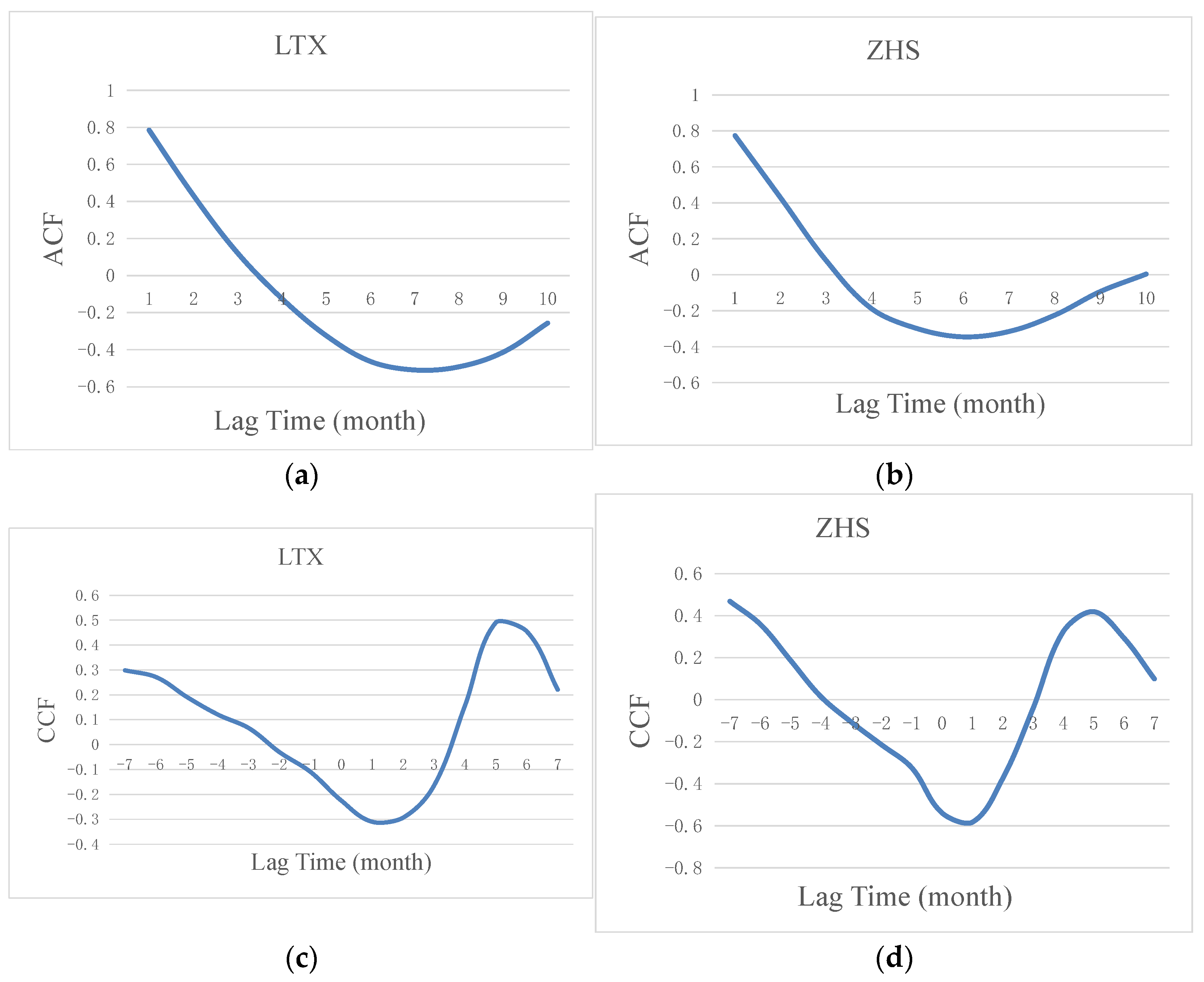
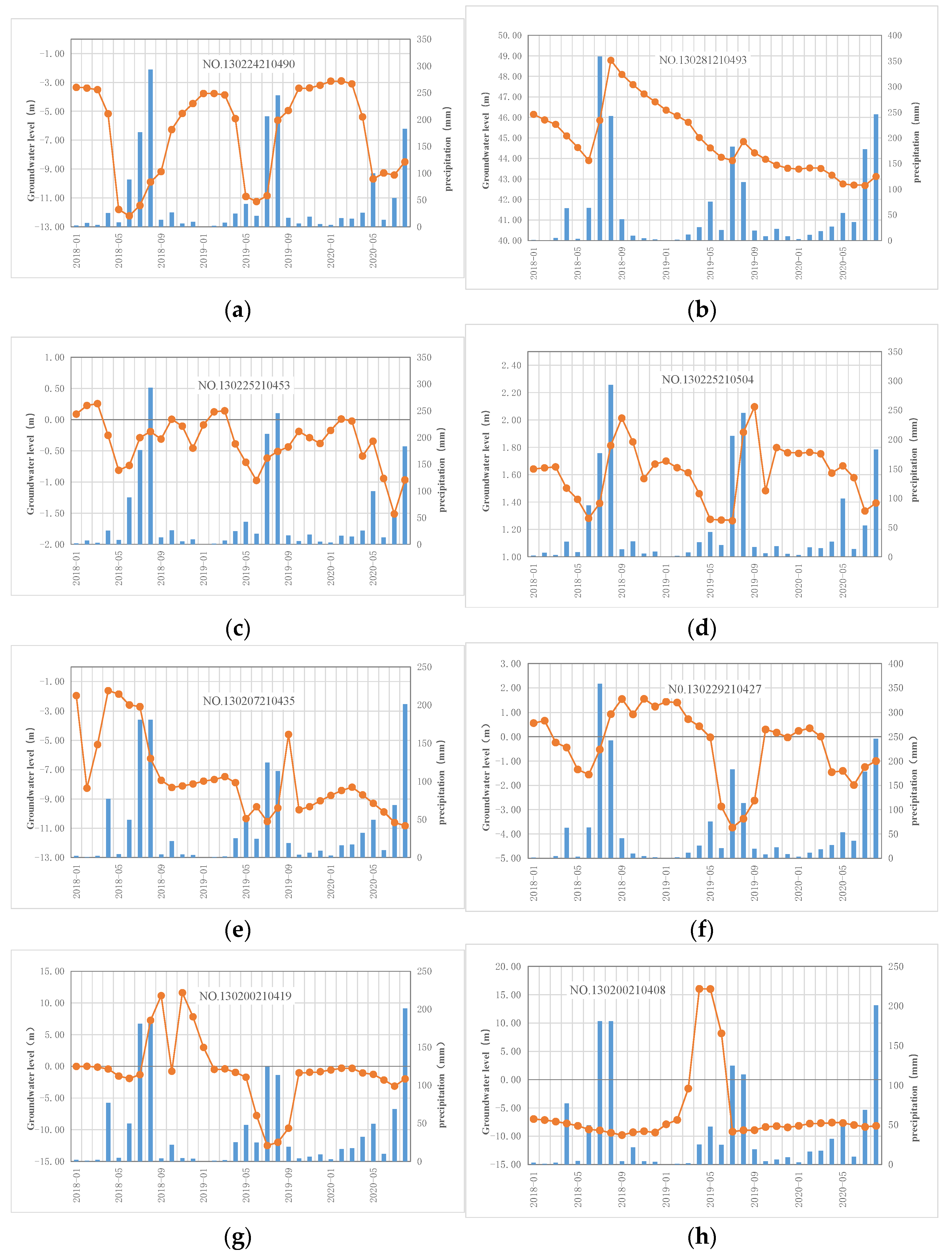
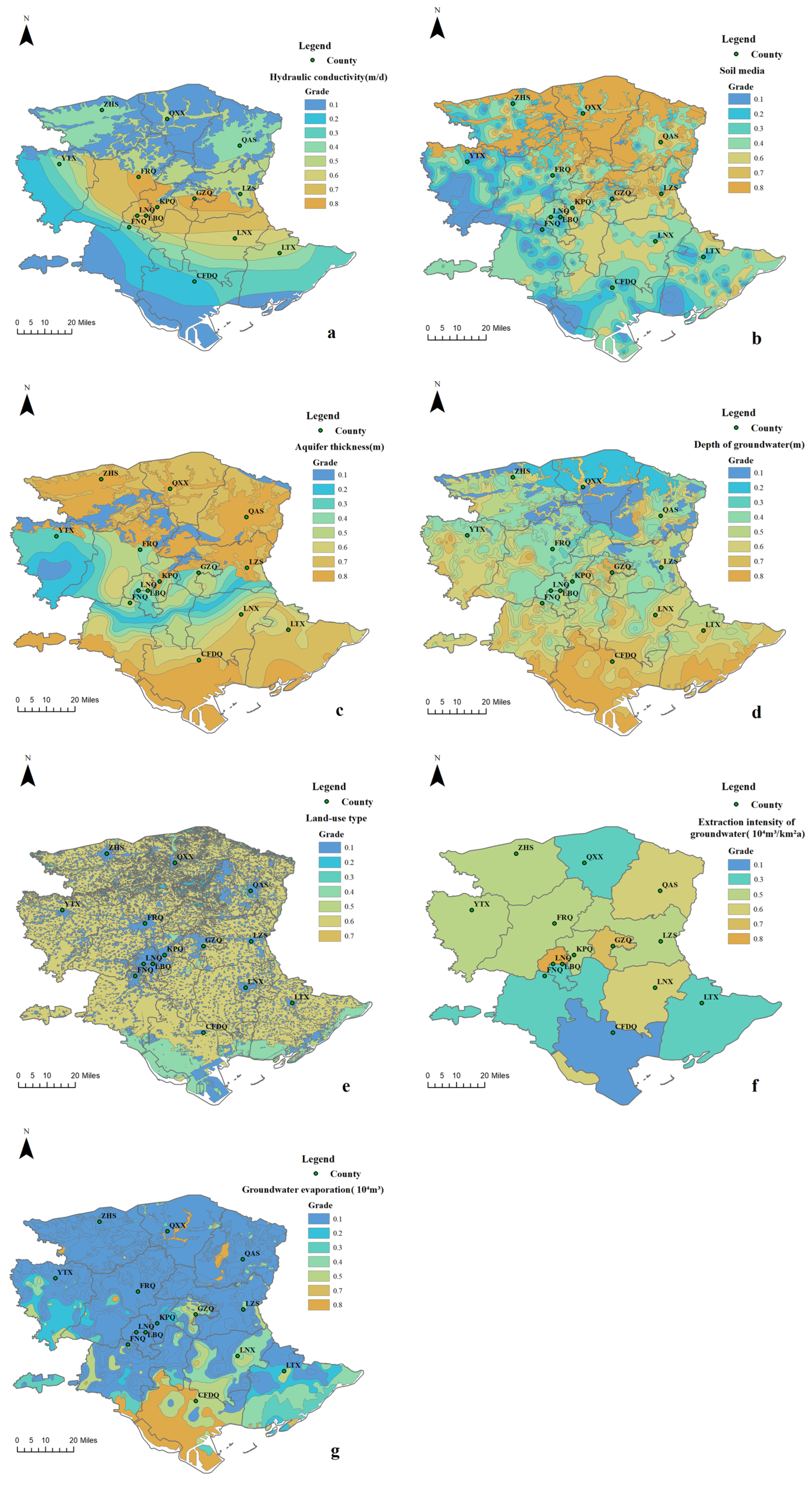
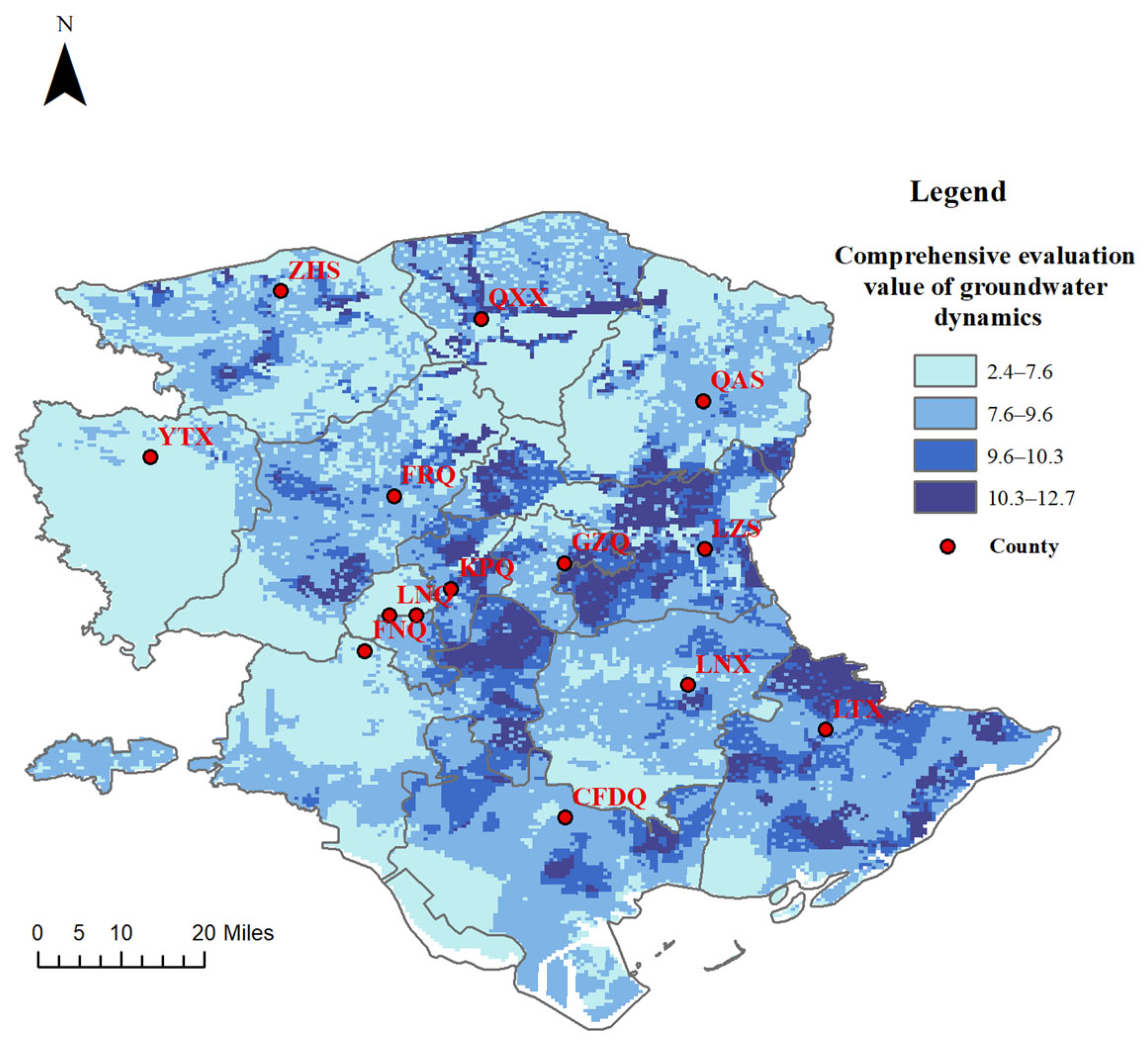
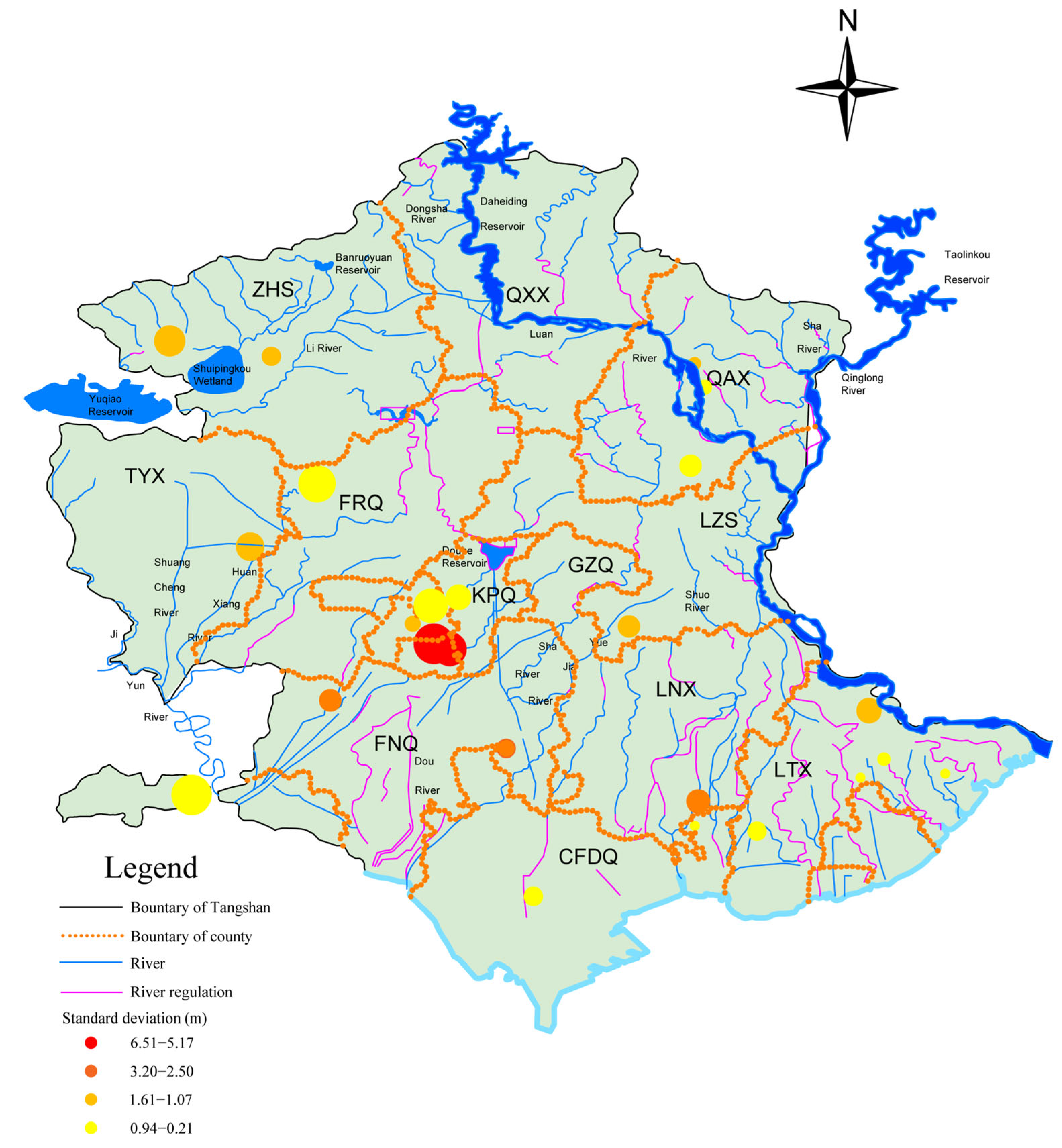
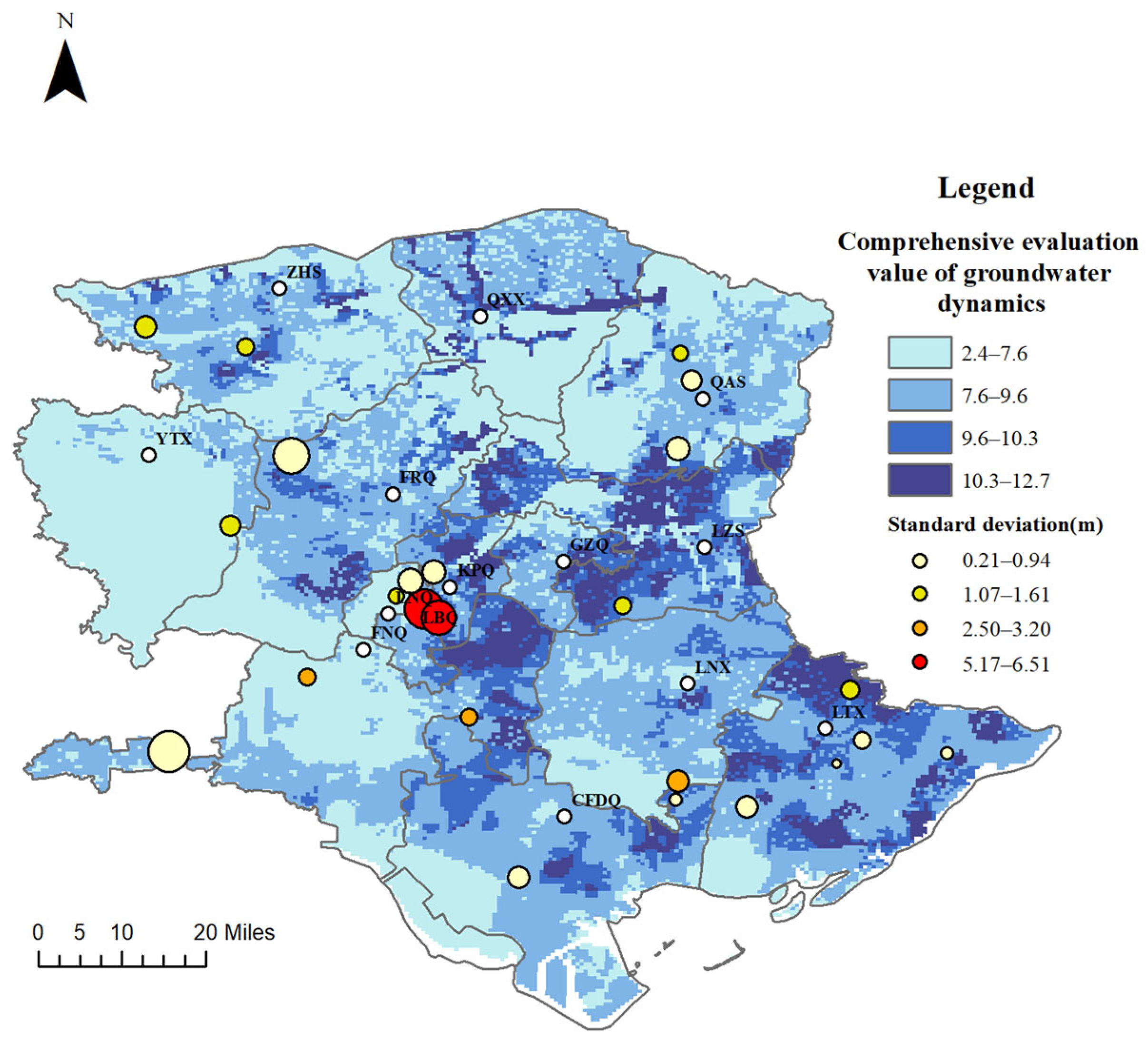
| Factors | Introduction | Weight |
|---|---|---|
| Hydraulic conductivity | Measures the aquifer’s permeability to determine the flow rate within the aquifer. | 6 |
| (C) | ||
| Soil media | Soil particle size is related to infiltration rate. | 5 |
| (S) | ||
| Aquifer thickness | Aquifer thickness is obtained by combining borehole data with groundwater depth. | 4 |
| (A) | ||
| Groundwater depth | Groundwater depth is the distance from the surface to the phreatic water table, which influences the migration time of precipitation. | 6 |
| (D) | ||
| Land use type | Land use type represent the natural and artificial distribution of features on the Earth’s surface. It affects the spatial and temporal dynamics of groundwater systems. | 2 |
| (LUT) | ||
| Extraction intensity of groundwater | Groundwater extraction intensity is used to measure the rationality of groundwater development and utilization, as it can weaken the recharge effect of precipitation on groundwater. | 5 |
| (EI) | ||
| Groundwater evaporation | An increase in phreatic evaporation depletes groundwater, leading to a decline in groundwater levels. There exists a critical depth beyond which evaporation effectively ceases and can be considered negligible. | 3 |
| (E) |
| Factors | Assessment Levels | |||||||
|---|---|---|---|---|---|---|---|---|
| 0.1 | 0.2 | 0.3 | 0.4 | 0.5 | 0.6 | 0.7 | 0.8 | |
| C (m/d) | [0, 12] | (12, 20] | (20, 30] | (30, 35] | (35, 40] | (40, 60] | (60, 80] | >80 |
| S | clay loam | silt loam | loam | sandy loam | swelling or condensing clay | silt-sand/fine sand | gravel-cobble/medium sand/coarse sand | thin layer or missing |
| A (m) | >40 | (35, 40] | (30, 35] | (25, 30] | (20, 25] | (15, 20] | (10, 15] | ≤10 |
| D (m) | >25 | (20, 25] | (15, 20] | (10, 15] | (6, 10] | (4, 6] | (2, 4] | ≤2 |
| LUT | artificial surfaces | forest | wetland | water bodies | grassland | cultivated land | bare land | |
| EI(104 m3/km2 a) | ≤2 | (2, 4] | (4, 6] | (6, 8] | (8, 10] | (10, 12] | (12, 15] | >15 |
| E(104 m3) | ≤1000 | (1000, 8000] | (8000, 12,000] | (12,000, 20,000] | (20,000, 90,000] | (90,000, 110,000] | (110,000, 160,000] | >160,000 |
| Data | Source of Data | Time Span |
|---|---|---|
| groundwater level | Groundwater data were obtained from actual monitoring wells, the locations of which have been projected in Figure 1. | January 2018 to August 2020 |
| precipitation | Precipitation data were obtained from three precipitation gauge stations located in Zunhua, Tangshan, and Leting. | January 2018 to August 2020 |
Disclaimer/Publisher’s Note: The statements, opinions and data contained in all publications are solely those of the individual author(s) and contributor(s) and not of MDPI and/or the editor(s). MDPI and/or the editor(s) disclaim responsibility for any injury to people or property resulting from any ideas, methods, instructions or products referred to in the content. |
© 2025 by the authors. Licensee MDPI, Basel, Switzerland. This article is an open access article distributed under the terms and conditions of the Creative Commons Attribution (CC BY) license (https://creativecommons.org/licenses/by/4.0/).
Share and Cite
Zhang, Q.; Zhang, M.; Jiang, W.; Hao, Y.; Chen, F.; Zhang, M. Characterization of Groundwater Dynamics and Their Response Mechanisms to Different Types of Compound Stress in a Typical Hilly Plain Area. Water 2025, 17, 1846. https://doi.org/10.3390/w17131846
Zhang Q, Zhang M, Jiang W, Hao Y, Chen F, Zhang M. Characterization of Groundwater Dynamics and Their Response Mechanisms to Different Types of Compound Stress in a Typical Hilly Plain Area. Water. 2025; 17(13):1846. https://doi.org/10.3390/w17131846
Chicago/Turabian StyleZhang, Qian, Meng Zhang, Wanjun Jiang, Yang Hao, Feiwu Chen, and Mucheng Zhang. 2025. "Characterization of Groundwater Dynamics and Their Response Mechanisms to Different Types of Compound Stress in a Typical Hilly Plain Area" Water 17, no. 13: 1846. https://doi.org/10.3390/w17131846
APA StyleZhang, Q., Zhang, M., Jiang, W., Hao, Y., Chen, F., & Zhang, M. (2025). Characterization of Groundwater Dynamics and Their Response Mechanisms to Different Types of Compound Stress in a Typical Hilly Plain Area. Water, 17(13), 1846. https://doi.org/10.3390/w17131846







